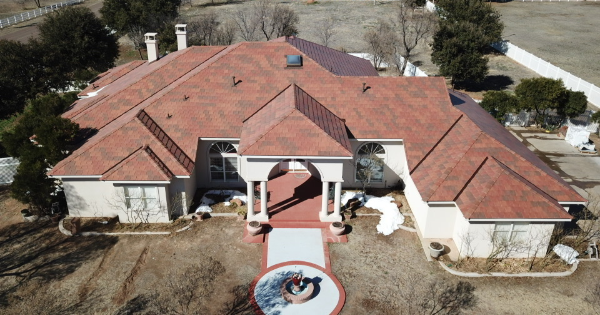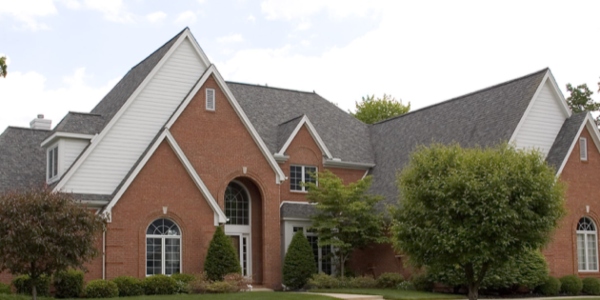Working With an Insurance Adjuster to Get a New Roof

By DaVinci Roofscapes.
Here's the top ten tips you need to know for working with insurance adjusters.
This is the time of year when hurricane season is winding down. Look around at your property and you may see damage. You may also need to hire a professional roofer to evaluate potential damage to your roof. If that damage is found, your next contact should be to an insurance adjuster. Don’t panic. We’re here with step-by-step tips to make that process easy.
10 tips on working with insurance adjusters
Trent Lovewell knows what it’s like to work with insurance adjusters. He reroofs homes in Omaha, Nebraska, where Mother Nature repeatedly damages roofs. His company, John Higgins Weatherguard, Inc., has actually installed more than 500 DaVinci Roofscapes composite roofs. Why? Because after other roofs fail, Lovewell recommends DaVinci roofs to homeowners. They stand up to Mother Nature and resist impact, strong winds and severe weather.
However, before his clients get their replacement roofs, they often must deal with insurance adjusters. To help them get through this process easily, he’s developed this list of 10 tips for working with insurance adjusters:
- Tip 1 – Be on time for an adjuster appointment.
- Tip 2 – Participate in your first adjuster overview appointment. Do not leave the meeting to your contractor, roofer or remodeler. Adjusters want to meet just with the homeowner for the first meeting and not have a contractor looking over their shoulder.
- Tip 3 – If you have pictures and other documentation of the initial damage, make sure to show the adjuster. Sometimes you need to remove a tree or tarp off an area of the roof. Take pictures before you do that and then share those pictures with the insurance adjuster.
- Tip 4 – Make a checklist of anything that got damaged as a result of the storm or situation and present the full list to the adjuster.
- Tip 5 – Understand that the adjuster will be at your home for several hours. Adjusters need to thoroughly review the damage resulting from the storm, which can include areas both outside and inside the home.
- Tip 6 – Not happy with the evaluation of the inspector? Ask the claim center for another inspection. You’re allowed a second inspection by law in most states.
- Tip 7 – If a second inspection is provided, don’t be surprised if the insurance company asks to have your contractor on site for this inspection. You can still participate, but a second inspection may be more thorough and require the expertise of your contractor.
- Tip 8 – Still not satisfied after the second inspection? Then talk to the claim center again. Ask if they can bring in an engineer to help evaluate the situation.
- Tip 9 – Don’t beat up on the adjuster. Sure you may have had your home insurance for 20 years and never filed a claim. While you may “feel” like you deserve a new roof, it doesn’t work that way. The adjusters follow a specific set of parameters to determine what type of reimbursement their agency will provide to you.
- Tip 10 – Honesty counts. In other words, the adjuster is there to evaluate the storm damage, so don’t try to include pre-existing problems in the claim. Just stick to pointing out what happened as a result of the storm.
What other homeowners have experienced
Gary Baker really did see the storm coming that ruined his roof.
“I saw this black cloud come up over the hills,” says Baker, owner of Grinders Switch Farm in Tennessee. “The first gust was ferocious. At least 90 mph. That storm took down several hundred trees on our property. It tore the metal roof off our guest house. In addition, it simply pulled the high-end asphalt shingles right off our main home.”
Immediately Baker started working with his insurance adjuster and his roofer. To protect his property and assure the roof overhead would remain intact during future storms, Baker chose a DaVinci composite roof.
Baker’s not the only homeowner to have gone through severe weather, lost a roof and then decided on a DaVinci replacement. In Texas, Mohan Singh had more than 100 cracked concrete roof tiles on his roof after a storm; that’s when he decided on a DaVinci roof. In Missouri, Samuel Baker watched 3-inch diameter hail destroy his roof. Afterwards he chose impact-resistant Select Shake. And, in the Walnut Lakes subdivision in Nebraska, 15 homeowners decided to invest in DaVinci roofs after a hail storm.
Why composite roofing?
Crafted of virgin resins, UV and thermal stabilizers, plus a highly-specialized fire retardant, DaVinci tiles are made to stand up to Mother Nature’s fury. They can take gale-force winds, chunks of hail and lots of rain. They’ve achieved Class 4 Impact Ratings and 110 mph Wind Ratings. This means that, even when the weather turns ferocious, if you have a DaVinci roof, it’s unlikely that you’ll need your insurance adjuster’s number on speed dial.
For more details on storms, insurance adjusters and how homeowners have switched over to composite roofing, read these stories:
- How to Handle Storm Damage Repairs
- Home Exterior Upgrades that Make a Big Difference
- Insurance Companies Refuse to Insure Real Wood Shake Roofs
- Hail-Resistant Roof Gets Homeowner 20% Off Yearly Insurance Premiums
- What’s Behind the Beauty is Genius
Have a question? AskARoofer.
Learn more about DaVinci Roofscapes.
Find your local roofing contractor in the RoofersCoffeeShop® Contractor Directory.











Comments
Leave a Reply
Have an account? Login to leave a comment!
Sign In